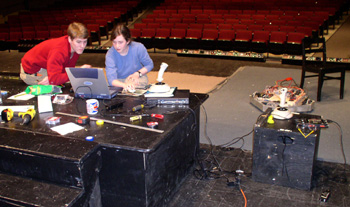Robotics
Revs Up
Team Begins Work on Robot
For ‘Rack ‘n’ Roll’ Competition
By Kelly Casteel (January 31, 2007)
The George Mason Robotics Team, also known as Vae Victus, has been working on
this year’s robot since “kick-off day” on January 6th. After traveling to Maryland to learn the details
of their assignment, they started the season with an all day meeting
to brainstorm possibilities. Senior members of the team agree that
the 2007 game, called "Rack 'n' Roll," is one of the most
exciting games the team has played.
|
 |
| In little more than two weeks, the
team constructed a full-size wooden model of "The Rack," the
scoring structure on which their robot will have to place inflatable
tubes. |
Senior team members Fritz Langford
and Kelly Casteel plow ahead with work on the robot. |
The
game is played with two "alliances" of three robots each. Alliances
score points by placing colored inner tubes on a nearly 10 foot tall
octagonal structure called "The Rack" in rows of one or more.
A team’s points increases exponentially with the length of the rows,
starting at two points for a row of one and capping out at 256 points
for a row of eight. The team has recently finished constructing a modified
version of “The Rack” to practice on.
During the last 15 seconds of the match,
alliances have the option of driving their robots back to their end of
the field and having them lift one another off the ground. Alliances
earn 15 points for each robot that is more than 4 inches off the ground
and 30 points for each robot that is more than 12 inches off the ground
at the end of the match.
This year, the George Mason team has opted
to focus on manipulating the inner tubes rather than lifting other robots.
They have already developed a holonomic drive
train, a unique arrangement of wheels that allows the robot to move in
any direction as well as rotate about an axis. This will allow the robot
to easily dodge defenders in addition to making fine adjustments while
hanging inner tubes. This design depends on the use of special wheels
called "omni wheels" that have rollers which allow them to
turn in one direction around an axle and be easily pushed in any other
direction. The driving code was nearly finalized this weekend, after
a number of failed attempts to compensate for biases and inconsistencies
in the speed controllers and motors. One such attempt resulted in the
robot spiraling wildly out of control and destroying a serial cable.
With those mistakes behind them, the team feels impressed with their
work and is optimistic about the possibilities for their innovative driving
system.
Designs for the arm and grabber are also
progressing forward. Team members and mentors have been working on prototypes
and drawings for all types of telescoping arms and grabbers. The team
even invited a salesman from Advanced Pneumatics, a company that sells
vacuum suction cups and other pneumatic equipment, to talk to the team
about the possibility of lifting the inner tubes with suction. But despite
the impressive demonstration, the team has instead opted to design a
mechanical grabber to get the rings off the floor and hold onto them
long enough to place them on “The Rack.”
In addition to competing in the Chesapeake
Regional at the Naval Academy from March 15-17, the team also plans to
attend the championship event in Atlanta from April 12-14.

